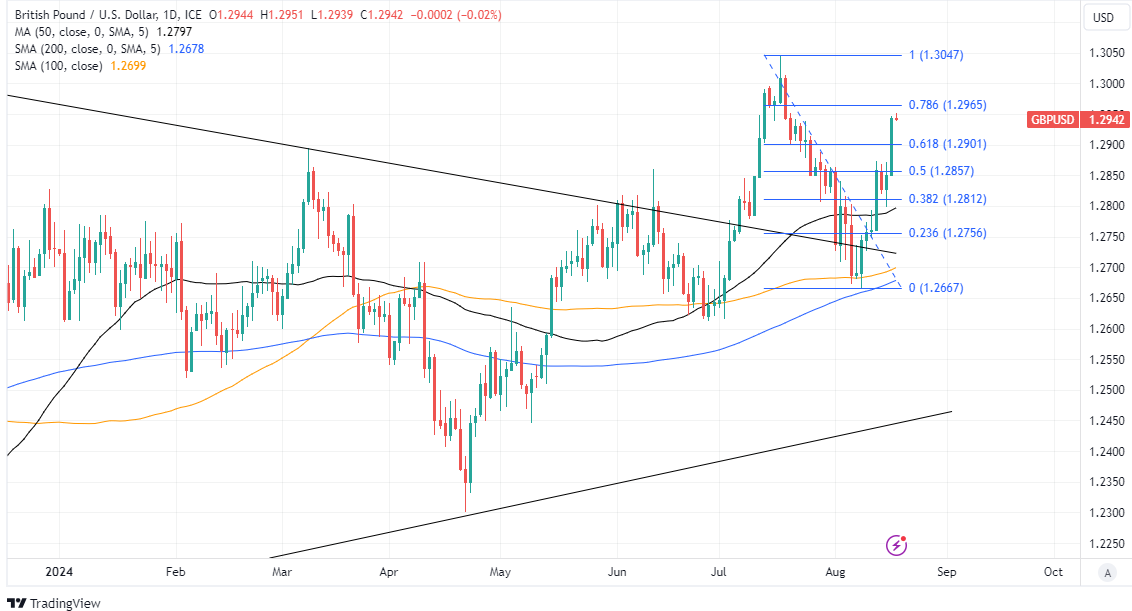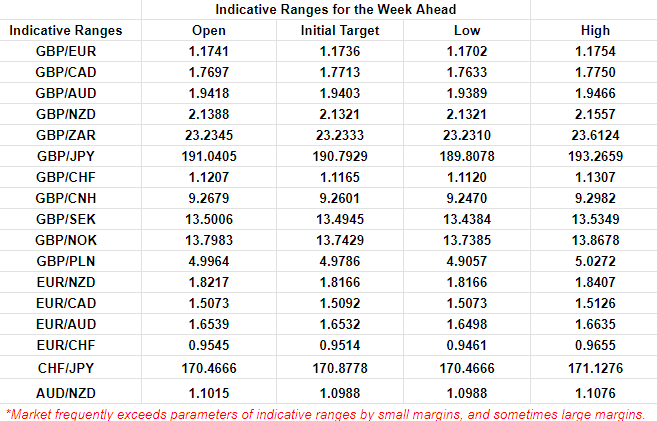Pound to Recover Further Ground against the Dollar this Week
- Written by: James Skinner

Image © Adobe Images
The Pound to Dollar exchange rate has rallied back strongly from its early August losses, with the charts and bilateral economic fundamentals suggesting further gains could still be likely up ahead.
Pound Sterling recovered multiple key levels on the charts against the Dollar last week in an extended recovery from its early August lows, including its 200-week moving average at 1.2845, the 50% Fibonacci retracement of its July fall at 1.2857 and the 61.8% retracement of the same downtrend at 1.2901.
But it could have scope to recover further lost ground, in part because US producer and consumer price figures suggested last week that further disinflation is in the pipeline, and as the July retail sales figures and jobless claims data out on Thursday have eased concerns about the risk of a US or global economic recession.
Above: Pound to Dollar rate shown at daily intervals with selected moving averages and black trend lines denoting a narrowing symmetric triangle indicating possible areas of technical support, while Fibonacci retracements of July downtrend highlight possible technical resistances.
With the UK economic story playing little, if any part in the late July and early August sell-off in GBP/USD, and the international themes that caused it having abated for now, there may be scope to Sterling to rise further in the short-term and perhaps to, or even above the 78.6% retracement of the July fall at 1.2965.
That would bring the year-to-date high at 1.3047 into focus, which is the last defence of the July 2023 high at 1.3145. Any break above here in either the short or medium-term would signal a continuation of the longer-term recovery from September 2022 lows that stalled in the summer of last year.
Compare Currency Exchange Rates
Find out how much you could save on your international transfer
Estimated saving compared to high street banks:
£25.00
Free • No obligation • Takes 2 minutes
Meanwhile, Pound Sterling was supported by solid domestic releases, including GDP, inflation and labour market figures. “The fundamental/secular positives remain the same and we are reassured that recent weakness has not been a reflection on the UK macro-outlook,” BofA Global Research strategists said.
“The UK economic backdrop played virtually no part in GBP's recent slide. There is little or no evidence of a significant deterioration in the UK macro picture,” the BofA team added in a note to clients on Thursday.
“GBP/USD can follow the USD trend over most of the week. A softer USD can support GBP/USD. The UK flash PMIs for August can continue to show the UK economy remains resilient, also supporting GBP/USD,” Commonwealth Bank of Australia strategists said in a note to clients on Sunday.
Both Sterling and the Dollar are likely to be sensitive on Thursday to the outcome and implications of the latest S&P Global PMI surveys. Any signs of continued resilience in the UK would be likely to support GBP/USD, and more so if accompanied by any suggestion of US economic momentum moderating further.
Above: Pound to Dollar rate shown at weekly intervals with Fibonacci retracements of June 2021 downtrend and selected moving averages highlighting the bullish medium-term technical picture for Sterling. Click the image for closer or more detailed inspection.
However, the main event of the week ahead is the Federal Reserve’s Jackson Hole Symposium where both Chairman Jerome Powell and Bank of England Governor Andrew Bailey are set to speak on the final day of the event on Friday. Both sets of remarks could have an equally significant impact on GBP/USD.
The focus will be on whether Powell either validates or pushes back against current market pricing for as much as 100 basis points worth of interest rate cuts from the Fed this year. Meanwhile, many will be interested to hear what last week’s UK data deluge means for the BoE’s interest rate in the months ahead.
Another factor that could become increasingly supportive of Sterling and cumbersome for the Dollar in the weeks and months ahead is the recent evolution of US election opinion polls, which now suggest Democratic Party candidate Kamala Harris is leading former President Donald Trump in multiple key swing states.
“I still think a Harris presidency is bearish US growth and bearish US stocks and bearish the US dollar, but the market isn’t trading that way right now,” says Brent Donnelly, president at Spectra Markets and a veteran FX trader with a career spent between major banks like HSBC, Nomura and Lehman Brothers.
“The Biden administration has been lambasted for the 2020/2021 inflation shock and the Dems’ desire to push inflationary fiscal policy in 2025 is probably not nearly as boisterous as DJT’s. Many provisions of the TCJA also come up for renewal on December 31, 2025, and it’s unlikely that a Kamala Harris government would be keen to renew Trump’s signature legislation,” he said in the am/FX daily macro newsletter.
Above: Quantitative model estimates of possible ranges for the week. Source: Pound Sterling Live.







